What Is a Microphone? Where Sound Meets Technology
Published: 18 Oct 2025
Have you ever talked on a video call, recorded your voice, or sung a song on a computer? The small device that captures your voice is a microphone!
We use microphones almost every day, while chatting online, making YouTube videos, or using voice commands on our phones. This tiny device helps us share our voice with others and makes communication easy and fun.
You can find microphones in computers, phones, studios, classrooms, and even smart speakers. They play an important role in both work and entertainment.
In this article, you’ll learn what is microphone, how it works, its main parts, types, and uses, all explained in simple and clear language.
What is a Microphone?
A microphone is an input device that changes sound energy into electrical energy. When we speak or make a sound, the microphone catches those sound waves and turns them into small electrical signals. These signals can then be recorded, sent to another device, or processed by a computer.
In simple words, a microphone works like a bridge between your voice and the machine. It allows your computer, phone, or any other gadget to receive sound and use it in different ways, like recording, calling, or giving voice commands.
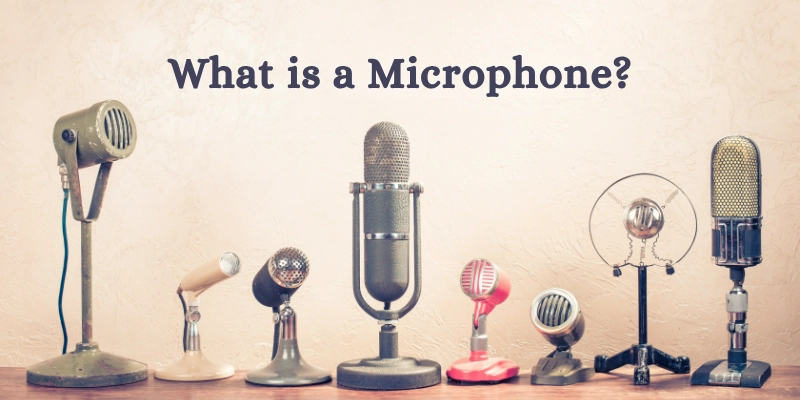
The meaning of a microphone is very easy to understand. It is a device that helps your computer or phone “hear” sounds, just like your ears do. When you talk, sing, or make any noise, the microphone listens and sends that sound inside the device so it can be saved or shared.
So, whenever you use your phone to record a song, make a video call, or ask a question to Google Assistant, your microphone is doing all the listening work!
Example:
Let’s take a few simple examples:
- When you talk on a video call, your voice goes through the microphone so the other person can hear you.
- When you record a song, the microphone captures your singing and sends it to the recording software.
- When you say “Hey Google” or “Alexa,” the microphone picks up your words so the device can respond.
From phones and laptops to cameras and studio equipment, microphones are used almost everywhere in our daily lives.
How Does a Microphone Work?
Have you ever wondered how a microphone works when you talk or sing? Let’s understand it step by step in a very simple way:
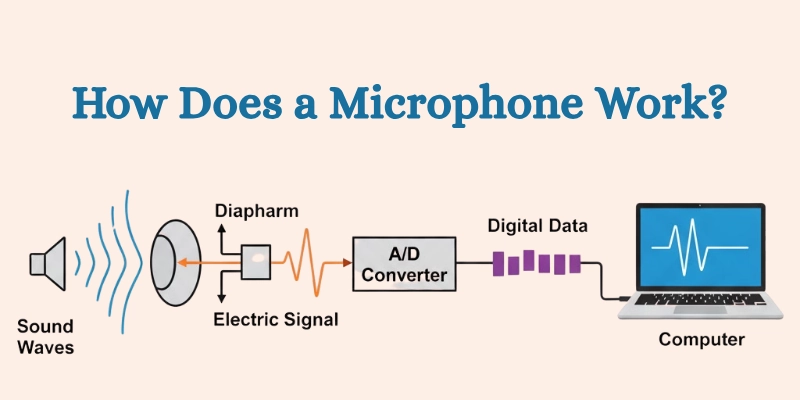
- You speak or make a sound.
When you talk, sing, or play music, sound waves move through the air. - The microphone’s diaphragm vibrates with the sound waves.
Inside the microphone, there is a thin part called a diaphragm. It moves (vibrates) when the sound waves hit it. - These vibrations are converted into electrical signals.
The microphone changes those tiny vibrations into small electrical signals that carry the sound information. - The computer or recording device processes these signals into digital sound.
These signals are then sent to your computer, phone, or recorder, which turns them into digital sound that can be saved, edited, or shared.
This whole process is called the working of a microphone, and it happens in just a few seconds, even faster than you can blink!
Example:
Think about when you record a song on your computer or phone. The microphone captures your voice, turns it into a digital signal, and saves it as an audio file. That’s how your real voice becomes a computer sound!
Parts of a Microphone
A microphone is made up of several small parts that work together to capture sound and send it to your computer or other devices. Let’s look at the main parts of a microphone and understand their simple functions.
| Part Name | Function | Simple Explanation |
| Diaphragm | Detects sound waves | It vibrates when sound hits it. |
| Coil or Condenser Plate | Converts vibrations into signals | It turns sound vibrations into electrical energy. |
| Magnet | Helps create an electric current | It works with the coil to make an electric signal. |
| Casing | Protects inner parts | It is the outer body that keeps the microphone safe. |
| Cable or Connector | Transfers a signal to the computer | It connects the microphone to a device to send sound. |
Each part plays an important role in the microphone structure. The diaphragm catches the sound, the coil or condenser plate changes it into signals, the magnet helps produce current, the casing protects everything inside, and the connector sends the sound to the computer.
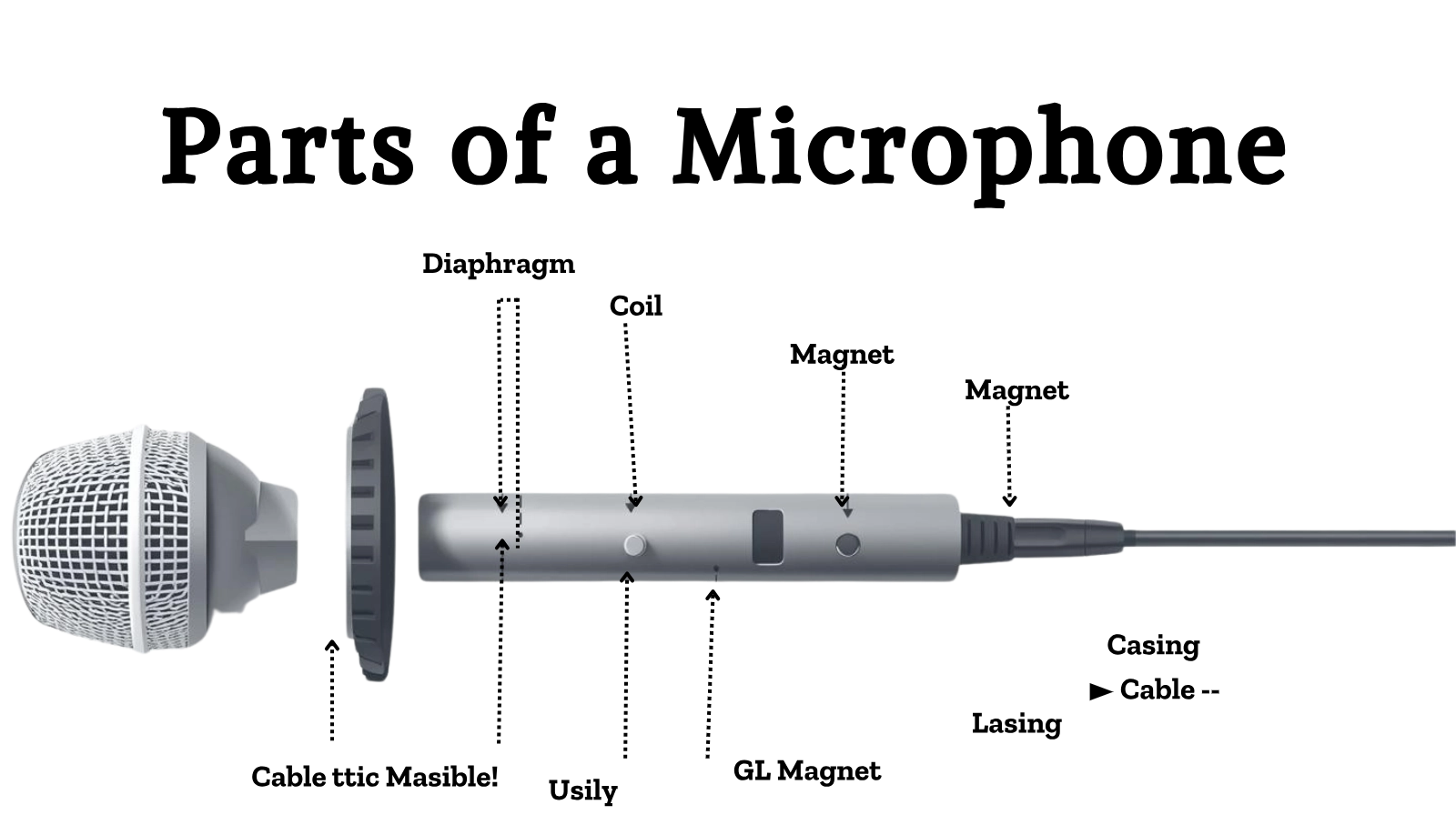
Together, these components of a microphone help it listen, convert, and send sound clearly and accurately.
Types of Microphones
Microphones come in many types based on how they work, how they connect, and where they are used. Each type has its own special design and purpose.
Let’s look at the main types of microphones.
- Based on the Working Principle
- Based on Connection Type
- Based on the Direction of Sound Pickup
Let’s look at them in detail.
Based on the Working Principle
Each type of microphone is useful in different situations. A dynamic microphone is perfect for stage performances, a condenser microphone is best for recording music or podcasts, and a ribbon microphone is great for smooth, professional sound.
Let’s look at the main types of microphones based on their working principle.
| Type | Description | Best Use | Example |
| Dynamic Microphone | It uses a coil and a magnet to turn sound waves into electrical signals. These mics are strong and can handle loud sounds easily. | Live concerts, stage shows, speeches | Shure SM58 |
| Condenser Microphone | It uses two capacitor plates that move when sound hits them. This type is more sensitive and records clear and detailed sound. | Recording studios, podcasts, YouTube videos | Blue Yeti, Rode NT1 |
| Ribbon Microphone | It uses a thin metal ribbon placed between magnets to capture sound smoothly. It gives a warm and natural sound quality. | Radio stations, voiceovers, professional audio work | Royer R-121 |
Based on Connection Type
Microphones are also divided by how they connect to computers or other devices. Some use cables, while others work without wires.
Let’s look at the main types of computer microphones based on their connection type.
| Type | Description | Example |
| Wired Microphone | It connects to a device using cables. These microphones are reliable and often used in studios for clear sound quality. | Traditional studio mics |
| Wireless Microphone | It works without cables and uses Bluetooth or radio signals to send sound. These are great for stage shows, YouTube videos, or public speaking. | Handheld wireless mic |
| USB Microphone | It connects directly to a computer through a USB port. Easy to use and perfect for podcasts, online classes, or gaming. | Blue Snowball, Fifine K690 |
Based on the Direction of Sound Pickup
Microphones can also be grouped by the direction from which they capture sound. This is called their sound pickup pattern. Some microphones hear sounds from all sides, while others focus on one specific direction.
Let’s look at the main types:
| Type | Description | Sound Pickup Pattern |
| Omnidirectional Microphone | Captures sound from all directions equally. It is great for group discussions or natural sound recording. | 360° sound |
| Unidirectional (Cardioid) Microphone | Captures sound mostly from one direction, the front. It reduces background noise and focuses on the speaker’s voice. | Front-focused recording |
| Bidirectional Microphone | Captures sound from the front and back, but not from the sides. Perfect for interviews or two-person setups. | Front and back |
| Shotgun Microphone | Captures sound from a narrow, focused direction. Commonly used in films, videos, and TV shows. | Highly directional |
Uses of Microphone
Microphones are an important part of our daily lives. They help us talk, record, teach, and entertain.
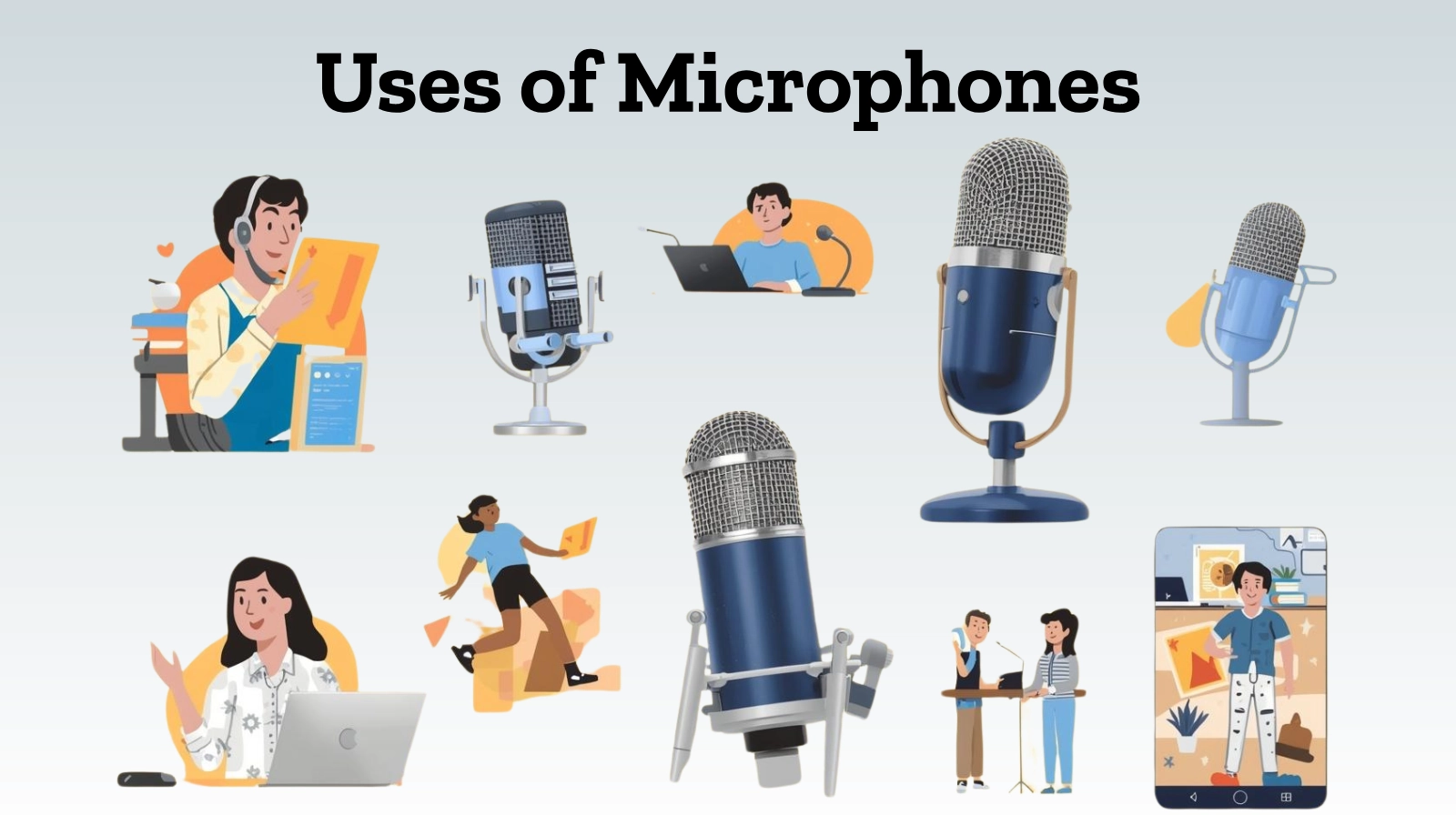
Let’s look at the main uses of a microphone in different areas.
- Computers and Laptops:
Microphones are widely used in computers and laptops for many purposes. They help people in voice calls, voice typing, online meetings, and gaming communication. Without a mic, we couldn’t talk or record easily on these devices. - Education:
In modern learning, microphones are very useful. Teachers use them during online classes to explain lessons clearly, and students use them to record lectures or give presentations. This shows the real importance of a microphone in education. - Music and Entertainment:
Microphones play a big role in the music and entertainment industry. Singers use them to record songs, YouTubers and podcasters use them for clear voice quality, and streamers use them for live audio. A good microphone makes sound more natural and professional. - Public Announcements:
Microphones are also used in public events, schools, offices, and meetings. They help in amplifying the speaker’s voice so everyone can hear clearly. This is one of the most common applications of a microphone in daily life. - Mobile Phones and Smart Devices:
Every mobile phone and smart device, like Alexa or Google Assistant, has a built-in microphone. It helps with voice commands, calling, and virtual assistant features. You can talk to your phone or smart speaker easily because of this tiny but powerful device.
Microphones make our digital world more connected and interactive. From classrooms to concerts, they play an important role in communication and creativity.
Advantages and Disadvantages of a Microphone
Just like every device, a microphone has both good and bad sides. It helps us record and communicate easily, but it also has some small drawbacks. Let’s look at the benefits and drawbacks of a microphone.
| Advantages | Disadvantages |
| Captures voice and sound clearly | May pick up unwanted background noise |
| Useful for communication and recording | Needs power or batteries |
| Many types for different uses | Sensitive and can break easily |
| Improves online learning and meetings | Wireless types can face signal issues |
Importance of Microphones in Daily Life
A microphone is a small but powerful device that helps us in many ways every day. It allows us to talk, record, learn, and control smart devices using our voice.
Whether it’s a phone call, online class, or voice assistant, microphones make communication easy and clear. Let’s see how microphones are important in our daily lives.
- 🎤 Online Communication:
Microphones help us talk clearly in voice calls, video meetings, and online chats. - 🧑🏫 Teaching and Learning:
Teachers use microphones in online classes, and students use them to record lessons or give presentations. - 🎶 Music and Entertainment:
Singers, YouTubers, and podcasters use microphones to record songs, videos, and shows with clear sound. - 🤖 Smart Voice Devices:
Smart assistants like Alexa, Google Assistant, and Siri use microphones to hear and understand our voice commands. - 🦻 Hearing Aids:
Microphones in hearing aids help people hear sounds clearly in daily life. - 💡 AI and Sound Systems:
In AI systems, microphones detect sounds for voice search, translation, and sound recognition.
Future of Microphone Technology
The future of microphone technology is bright. Modern microphones are becoming smarter, smaller, and clearer.
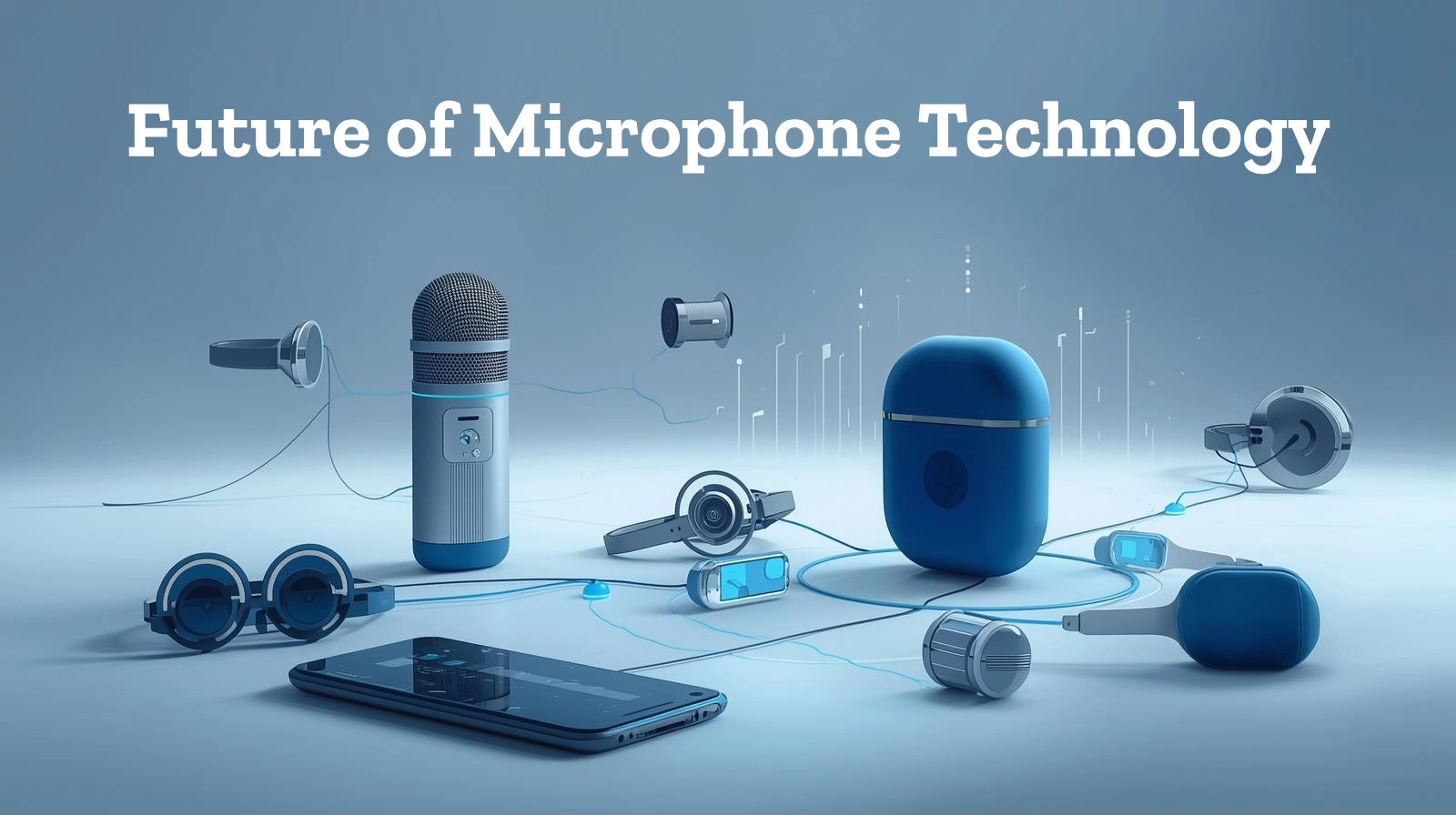
They will work better with AI, smart devices, and everyday gadgets.
- AI Noise-Canceling Microphones:
Future microphones will use AI to remove background noise and make voices sound clear. - MEMS Microphones in Mobile Phones:
Tiny MEMS microphones will be used more in phones because they save space and capture sound accurately. - Smart Microphones for Wearables:
New smart microphones will be built into smartwatches, earbuds, and glasses for easy voice use anywhere. - Connected with Voice Assistants and IoT:
Microphones will work with Alexa, Google Assistant, and smart home devices, helping people control things by voice.
Conclusion
A microphone is a small but powerful device that helps us talk, learn, record, and enjoy music or videos. It plays an important role in our daily life, from online meetings and classes to songs and smart devices.
Microphones make communication, learning, and entertainment possible in the digital world. They help us stay connected and express ourselves easily.
From your phone to your classroom, microphones are the ears of modern technology, always ready to listen and help you connect. 🎤💬
FAQs
🤔 Have more questions in mind? Let’s explore some quick and simple FAQs about microphones!
A microphone is an input device that captures sound and sends it to a computer. It changes sound waves into electrical signals for recording or processing.
There are many types, such as dynamic, condenser, ribbon, wireless, and USB microphones. Each type works differently based on its design and use.
It helps the computer receive and record voice or sound. You can use it for calls, voice typing, or audio recording.
The two most used types are dynamic and condenser microphones. They are common in studios, podcasts, and live shows.
The main characteristics are sensitivity, frequency response, and directionality. These features decide how the microphone captures and reproduces sound.
Using two microphones helps capture sound from different directions. It gives better balance and natural audio quality.
The rule says that the distance between microphones should be at least three times the distance from the sound source. This helps avoid echo and sound interference.
Most microphones can capture frequencies up to 20,000 Hz, which is the limit of human hearing. Some high-end models can go even higher for special recordings.

- Be Respectful
- Stay Relevant
- Stay Positive
- True Feedback
- Encourage Discussion
- Avoid Spamming
- No Fake News
- Don't Copy-Paste
- No Personal Attacks

- Be Respectful
- Stay Relevant
- Stay Positive
- True Feedback
- Encourage Discussion
- Avoid Spamming
- No Fake News
- Don't Copy-Paste
- No Personal Attacks





